
The category of constructed / staged / performative photographs implies a control of the elements over the image, in a “directorial mode.”[1] It has existed as a distinct yet very broad genre since the late seventies, even though one may argue that images have been staged since photography’s inception as a medium. Emerging as a postmodern turn to the idea of truth, authenticity and objectivity as claimed by straight photography, it constituted a move away from the realism of the documentary image. The photograph became subjective, culturally constructed, and whose meaning was guided by context, rather than by a privileged relation with reality. A reading of the photograph assumes prominence, and its concept, the context of its making, its presentation and reactions of the viewer become more important than the idea of a singular truth. Several of its influential practitioners like Les Krims, Cindy Sherman, Sandy Skoglund, Jeff Wall, Thomas Demand etc, are well known, though the list is very long and constantly growing. Each approach is individualistic, to communicate ideas, feelings, political positions, or just to challenge assumptions about the photograph. The canvas is wide open, and the possibilities infinite, more so with the advent of the digital.
In my photographic practice, I have considered photographs as documents, notations, and fragments of what makes our internal and external worlds, as multisensory experiences. Over time, the practice has come to include text, the moving image, installations with objects and constructed / staged / performative images. As the questions which I engaged with became increasingly complex, these forms have become integral to a visual vocabulary. Photographs can more than represent the world, they can present speculative ideas which spur new discourses. Here, I would like to provide the discursive and cultural context of two works, which fall in the category of constructed / staged / performance photographs. Through these, I hope to illustrate one of the many strategies which inform the making of such photographic images.
Immersion. Emergence (2006) and Rhizome (2015), are both based in the urgent ecological discourse of our times. They were produced as part of long projects, Alien Waters (2004-2006) and Else All Will Be Still (2013-2015), which examined the entangled ways in which the lived landscapes of rivers and seas have come to be shaped and inhabited in contemporary times, both spatially as well as temporally. Alongside, in terms of visual language, both works exceed the photograph as documentary in a classical sense, and evolved during the process of wider artistic investigations, as an attempt to express what was left unsaid. The impulse to create them lie in the intertwined epistemes of lived ecologies, and the complexity of the idea of nature. They have emerged from engagements with philosophical ideas, and with poets, activists and local communities, and help collapse the false nature-culture divide.
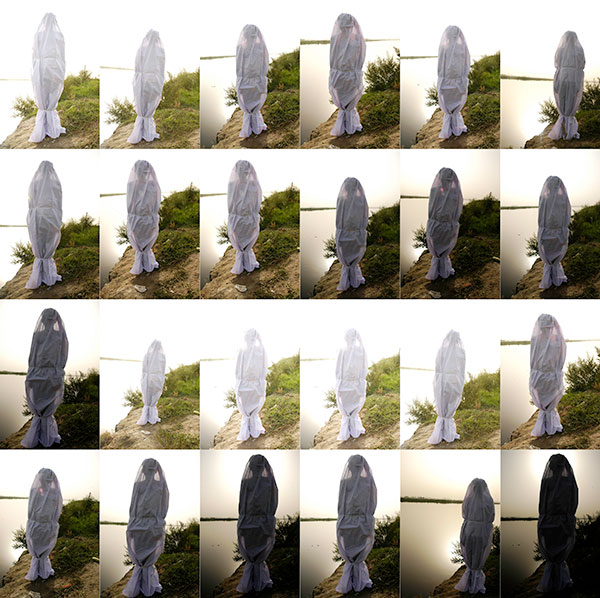 Immersion. Emergence (series of 24) (2006)
Immersion. Emergence (series of 24) (2006)
Immersion. Emergence (2006). This series of 24 performative photographs was the final work I did during the more than two-year-long engagement with the river in Delhi, viz. Alien Waters. It was an investigation into the history of colonization, industrialization and urbanization which had caused the defilement of nature, in this case the urban river. The enquiry was philosophical, discursive, historical, as well as artistic.
Documenting the state of the river, over a period of over two years, it was clear that its landscape was changing rapidly. From an urban-agrarian space cultivated with vegetables and some grain to service the city’s demand, its banks were now being transformed to serve its requirements of power, water treatment, recreational areas, and highways. Further, as the city had grown from a sleepy, bureaucratic town to a busy metropolis of enterprise and jobs, it needed cheap labor for new constructions, cleaning, scavenging, for shops, markets, restaurants, and as domestic help in households. The forgotten riverside emerged as temporary refuge for migrants. Slowly these habitats became communities, as their kith and kin from villages joined them, to become part of the new burgeoning urban labor market. Without warning, these communities were brutally and forcibly evicted from these forsaken riverside spaces. Land prices were rising as the city became global, and what was once uncared for wasteland, had become property to be claimed back by the city. Alongside, as the city’s sewage continued to drain into the river, it turned black with pollution, bereft of any life. Its waters had become “Alien,”[2] a term I borrowed from early Marx’s writings. It denoted the separation of the body of fish from the water which sustained it, owing to it being polluted, and later used by him to theorize capital’s relationship with surplus value. The term also located the current state of the river in a long history of capitalism’s externalization of nature from society, and an exclusion from the social contract itself. Post enlightenment, nature had been colonized in the service of mankind, to be controlled and shaped to serve its needs.
However, I felt there was something more, albeit in a somewhat discordant way. The roots of ecological loss seemed deeper than only caused by historical and material conditions. It gestured towards a loss of a more fundamental relationship. For me, another kind of response, which implicated the inner self was called for. The position of power over nature needed to be transformed to one of fragility and humility. All the while, though polluted and filthy, the waters had also held a deep timelessness and serenity. They were peaceful, calming, reflective, and revealed other dimensions of existence. The nearby cremation grounds were constant reminders of human vulnerability through death as a reminder of mortality. Culturally, the riverbank was full of religious rites which treated the river as goddess, and nature as supreme. These ignored the polluted waters, and only saw a purity, possibly a problematic Brahminical one. The local priest who ritualistically bathed in the black waters each day without fail, was evidence of this. The river evoked another reality, where death and rebirth were mere moments in a continuity of time. It was sacred space. A different ontological self was its witness. The alienation seemed other than just material or Marxian, it was also relational. Though not the epistemological domain of western materialistic philosophers, this had been part of the Advaitva philosophy of the Upanishads. Could they co-exist together? Possibly, since the contradictions of pollution and purity, death and life, hope and despair were everywhere one could see. I absorbed them deeply. The story was more complicated than was apparent. I stopped documenting the river – there was more to be said.
Immergence. Emergence was the outcome. It came from a deep need of what I felt was the unexpressed and unsaid in the documentation hitherto. The title of the work was too not without significance, and represented the cyclical processes involved. Once the image became clear to me, executing it took only a few days. A tailor made the shroud, a friend offered to take the pictures, and I already knew the site. Over the next few hours, I stood, covered in the white translucent cotton cloth, with my back to the setting sun, contemplating, waiting, in stillness and in hope.
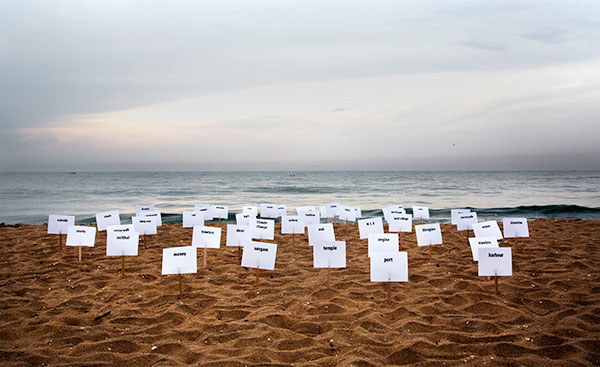 Rhizome (2015)
Rhizome (2015)
Rhizome (2015). This work was part of another three-year-long exploration viz: Else All Will Be Still. The sea was not what it appeared to be. It had been shaped and reshaped (and continues to be) by human interventions. A fishing village by the Bay of Bengal, on the southern coast of India, became the site for investigating the manner of its inhabitations. A two-thousand-year-old history, evidenced in the rudimentary kattumaran, a boat literally meaning “tied wood,” marked the generations of communities who lived and fished here as livelihood and a lifestyle. Everything was marked by the waters – rituals, hut architecture, clothing, daily routines, and relationships. Only now there was a tremendous flux of change – as the waters came closer to the huts, as the beach shrank owing to a port wall built a few kilometers up blocking the natural sand flow, as tourism, water sports, prostitution infested the beach and the fishermen slept on each night as deep sea commercial trawlers depleted the fish catch. The beach, a lifeline for fishers, without which they could not launch their vessels, was transforming politically, culturally, and economically. Only the change was so abstract, deep and unattributable to a single cause, that it was impossible to unravel it. Everything was interconnected, everything was triggering something else, everything was both a cause and an effect. As the feminist scholar Karan Barad had proposed in her term “agential realism,” it was a phenomenon [3] of something new emerging, owing to internal intra-actions amongst the myriad of forces surrounding it.
Rhizome was a result of trying to think of this complexity. It was again the final work in a long duration of engagement on the ground, and where I felt something more needed to be said. Physically it entailed the placing of plaque-cards with words on the beach. The words had been culled out from an ongoing series of conversations with the fishers over time, revolving around the question of what the sea meant to them. The sea I saw was clearly not the sea they saw – as was evident from the word they used to describe it. Not aesthetic, but functional and material. It depicted a close and multifarious relationship which could not be pared down to a singular one. Not only did this break the myth of a binary as posed in the man-nature fixity, but presented the problematics which this created. There seemed no way this could be reduced to livelihood, or culture, or technology etc, but its messy nature led to no clear-cut trajectories for redemption or restoration. The title Rhizome was derived from the term as suggested by the philosophers Deleuze and Guattari [4], who had assigned it to depict relations like that of roots which spread underground, dispersed, with no direction, no beginning and no end and no predictable path. It connoted an assemblage of things which are connected though unseen, underground, like a spider’s web, with no hierarchy of importance or possibility of isolating.
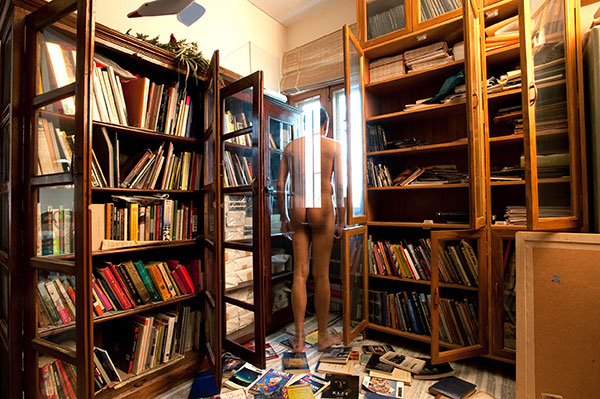 Library – Scene of Crime (series) (2009)
Library – Scene of Crime (series) (2009)
 Metalman II (series) (2008)
Metalman II (series) (2008)
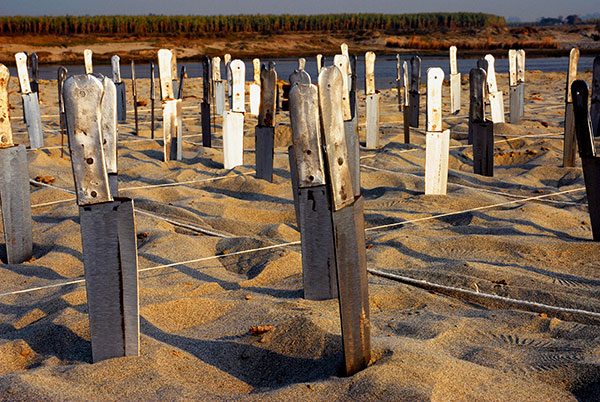 Riverbank I (2007)
Riverbank I (2007)
[1] A defining term provided by photography critic A.D.Coleman in 1976, which dethroned past “straight” and “pure” documentary form, advocated in very influential, modernist histories such as that by Beumont Newhall (in The History of Photography – 1938), to recognize a new genre. (See The Directorial Mode: Notes towards a definition in An A.D.Coleman Reader, Published Writings 1968-2017 – accessed at https://www.nearbycafe.com/artandphoto/photocritic/wp-content/uploads/2018/08/ADColeman-Reader-for-MoMA-Forum-2018.pdf on 16th July, 2020.)
[2] In The German Ideology, which is a set of manuscripts written by Karl Marx and Friedrich Engels around April or early May 1846 and here referred by John Ballamy Foster, Marx’s Ecology: Materialism and Nature (New York: NYU Press, 2000), 112.
[3] “A phenomenon is a specific intra-action of an ‘object’; and the ‘measuring agencies’; the object and the measuring agencies emerge from, rather than precede, the intra-action that produces them.” Barad, K. (2007). Meeting the Universe Halfway: Quantum Physics and the Entanglement of Matter and Meaning. Duke University Press. Pp 235.
[4] The concept of the Rhizome was developed by Giles Deleuze, and Félix Guattari (1987) in A Thousand Plateaus: Capitalism and Schizophrenia. Minneapolis: University of Minnesota Press.
Copyright © 2022, PhotoSouthAsia. All Rights Reserved.
Ravi Agarwal was invited to write this essay for PhotoSouthAsia by our Guest Editor, Sharbendu De. We encourage you to begin with De's introduction, Against Capturing - in a World of Ideas, and to also read De's other invited essayists:
Prajakta Potnis: In the Quest of an Undiscovered Location
Soumya Sankar Bose: Where an Improbable Reality Meets Fiction
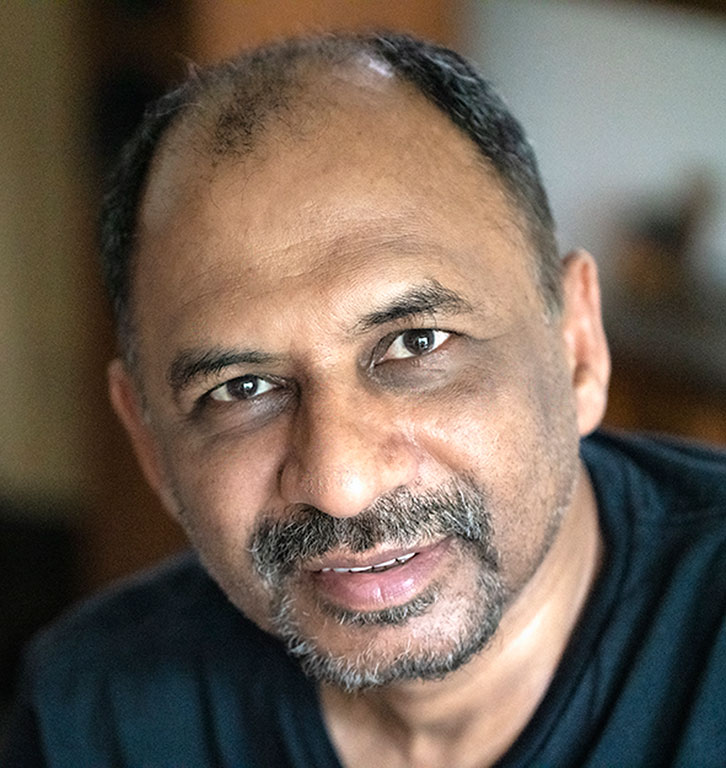 Photograph © Ravi Agarwal
Photograph © Ravi Agarwal
Ravi Agarwal's practice has an inter-disciplinary character from his engagements as an artist, environmental campaigner, writer, and curator. Bridging the divide between art and activism, it politicizes the entangled questions of nature and its futures. He uses photography, video, text, and installation to pose questions about ecology and society, culture, urbanity etc. He has been shown widely, including at Documenta XI, the Biennials of Havana (2019), Yinchuan (2018), Kochi (2016), Sharjah (2013) etc. He has also curated large public art projects such as the Yamuna-Elbe, twin city project (2011), and Embrace our Rivers, an Indo-European project (2018), and was the photography curator for the Serendipity Arts Festival 2018 and 2019. Agarwal's works are in several private and public collections, and he has authored and edited several books and journals. He is also founder / director of the environmental NGO, Toxics Link, and recipient of the UN Award for Chemical Safety and the Ashoka Fellowship.
20 November